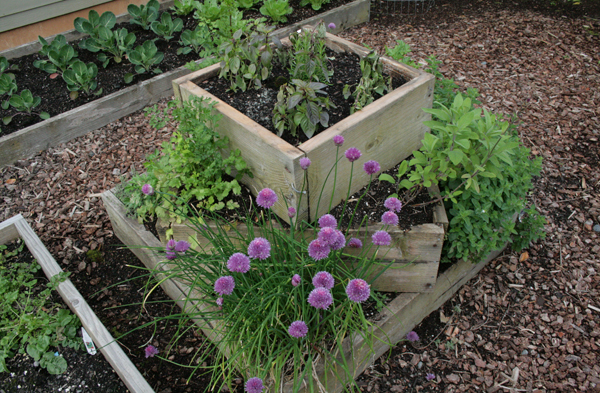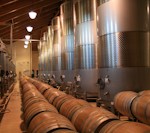Stacked Herb Garden Is Great Solution for Small Spaces
There’s nothing better for someone who loves to cook than to grow their own herbs.
I always look forward to spring and summer when I can just go out into the garden and snip Italian parsley, sage, rosemary, basil, thyme, oregano or chives to use in the kitchen.
We’ve lived in places where we’ve had lots of space for a vegetable and herb garden (Fort Worth, Texas) as well as places where we have had more limited space (Baltimore, Maryland and Salem, Oregon). Even though we have a nice-sized yard, the dirt in this part of Oregon is Jory clay, which is not great for growing much except pine trees. So I’ve resorted to a limited vegetable garden in an area of our yard that was not landscaped and used two raised beds measuring three feet by twelve feet. This gives me enough space to grow lettuce, sugar snap peas, green beans and bok choy most years.
The thing to remember when building raised beds is to use untreated wood. Treated wood has chemicals that will leech into your garden soil and end up in your vegetables.

My stacked herb garden is planted with chives, Italian parsley, cilantro, oregano, thyme, sage, basil and rosemary.
After putting in the raised beds for my vegetables, I decided that I needed a compact space where I could efficiently grow several varieties of herbs without having them crowd each other. I wanted to also make it easy to maintain. Using my graphic design skills, I came up with simple stacked square frames that looked like a pyramid once they were put together.
I decided that the bottom (and largest) level would be 4-foot square, and I used some twine and sticks stuck into the ground to mark this space. Then, to determine the size of the next level up, I marked the middle of each 4-foot side with another set of sticks stuck into the ground and connected those sets of sticks with more twine. I repeated this step for the third and smallest square that would be the top-most frame. See design below for a better idea of what I mean.
Then all I had to do was measure each side, go to the hardware store and have them cut untreated lumber to those lengths for me. I also got a box of roofing nails. Once I was home, I hammered together the squares and stacked them one on top of the other. I then filled the frames with a mixture of manure, topsoil, peat and planting mix, and planted the herbs. Over the years, this herb garden structure has served me very well and it’s given me great joy being able to grow my own herbs to use in the kitchen.
If you don’t have a lot of space, it might be the perfect solution for you.
Happy gardening and cooking!
— Vic
Category: Herbs
About the Author (Author Profile)
Victor Panichkul is a journalist and writer by training; a cook, wine lover and photographer by passion; and a lover of the outdoors since moving to Oregon more than 10 years ago. He is a native of Bangkok, Thailand.




























































Victor,
Your herb garden looks beautiful and sounds lucious.
Marlene
Thanks Marlene, we all enjoy cooking from it.
This same concept is used in Square foot gardening. Not only for herbs, but for anything one wishes to grow in a confined space.
I love this idea, I too have a limited garden space, but it doesn’t stop me from gardening food plants and trees. I’m going to steal your gardening by the stacked yard. I also love many of your recipes.
I Sicilian, thanks for your comment. Let me know how the stacked garden turns out!
Thanks for the idea! We took our old herb garden out today and put this in. The old one was overgrown with weeds. My 7 year old daughter was helping most of the time.
You’re welcome! I’m glad your daughter got into it too!
Useful design, Thanks
You’re welcome. Thanks for reading our blog and commenting!
I love this idea. Do you think it will still work if I covered the bottom and put it on my deck. I would like to protect it from the squirrels. Thanks
Yes, I think it will work as long as water can still drain from the bottoms
Sooo excited! We live in a mobile home community and already have taken up much of our yard with raised beds. This will help immensely, so we do not need to continue each year eating away at our space the more we plant! Thank you!
I am a master gardener in Dallas, TX. I would like to use your photo of the stacked herb garden in a presentation on herbs. Do I have your permission if you are given photo credit?
Yes you can use the photo
This is great! I just received a wooden herb garden frame made from untreated wood. I am wondering how the wood holds up without being treated? Should I use some kind of plastic liner before adding the soil?
Cheers!
Amy
Hi Amy, untreated wood should last you at least 3-5 years. The reason I don’t recommend using treated wood to grow vegetable plans is that the chemicals that are used in treating the wood can leach into the soil and end up in your vegetables. I would not worry about using a plastic liner or you’ll have drainage issues.
[…] How cool is this stacked box garden? I’m not sure how it would work for veggies, but it’s worth a try, right? [Source] […]
[…] Savor the Taste of Oregon […]